Feb-12-22
 | | KEG: Mieses, as always, wanted to be on the attack. Here, he overstretched, first sacrificing a pawn for complex play, and then missing his way and winding up in a pawn down ending he surely should have won. Fortunately for Mieses, von Popiel got sloppy and allowed the ending to drift to a book draw. A game neither player could have been proud of.
1. e4 c5
Mieses loved to play the Vienna Game (1. e4 e5 2. Nc3). von Popiel's decision to opt for the Sicilian Defense was thus reasonable, though Mieses had a pet variation in this opening as well, as will be seen. 2. Nc3 Nc6
3. g3
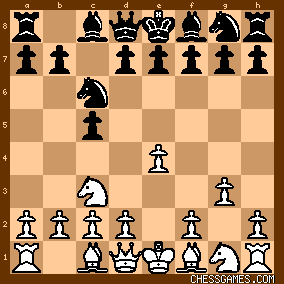
click for larger viewThis form of King's Indian Attack against the Sicilian was a Mieses favorite. 3... g6
4. Bg2 Bg7
5. Nge2
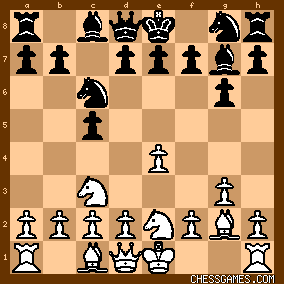
click for larger viewMieses' pet line. 5. d3 is more usual, but the text is certainly good as well, and Mieses knew its intricacies. Had I been a spectator at the time, I would have placed heavy odds that Mieses would win this game. (I would have lost). 5... d6
6. d3 Nf6
7. Bd2

click for larger viewA novelty at the time. 7. 0-0 is most usual. But Mieses here had an attacking scheme in mind. 7... Bd7
8. h3 a6
9. f4
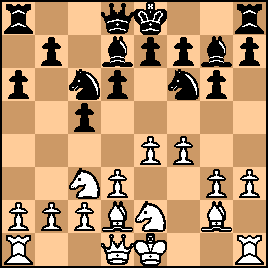
click for larger viewAs always, Mieses wanted to be on the attack. While 9. 0-0 seems simplest, there is nothing terribly wrong this Mieses' idea...thus far. 9... e5?!
Not bad, but giving rise to the sort of complex double-edged position in which Mieses usually excelled. He probably now expected to roll over his less-experienced opponent here. 10. 0-0
I would have expected 10. f5 from Mieses. The text, however, is certainly fine. 10... h6
11. Nd5
11. fxe5 or 11. a4 or 11. g4 or 11. f5 would all have been more in Mieses' style. But he was probably confident of victory against this opponent in this position and decided to proceed slowly. 11... NxN
12. exN Ne7

click for larger viewBeginning here, in a position in which he was certainly not worse, Mieses began to overrate his chances and drifted into an inferior game and later into a lost one. |
|
Feb-12-22
 | | KEG: Post II
13. Nc3
Mieses could have tried to nurse his tiny advantage beginning with 13. fxe5, but he was hardly Anatoly Karpov, and wanted more, and any edge he had enjoyed disappeared with the superficially appealing text. 13... 0-0
Sound, but 13...Qb6 would have given von Popiel some threats of his own. 14. Ne4
Again by-passing exf5, and now courting trouble. 14... Nxd5
von Popiel could have achieved the better game with the following exciting line 14...exf4. e.g., 15. Bxf4 Nxd5 16. Bxd6 Ne3 17. Qf3 NxR 18. BxR QxB 19. RxN f5 (better than 19...Bxb2 20. c3 Bc6 21. Qd1 with approximate equality) 20. Nc3 Bc6 21. Qf4 Qe8 22. Kh2 BxB 23. KxB b5 24. Qd6 Bd4 After 14...Nxd5, the position was:
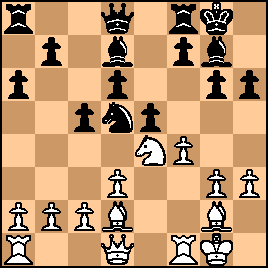
click for larger view15. c4?!
Seriously courting trouble. 15. Nxd6 would--as noted in the Tournament Book--have been answered by 15...Bc6, but is was much better and sounder than the text. 15... Ne7
16. fxe5 dxe5
17. Be3
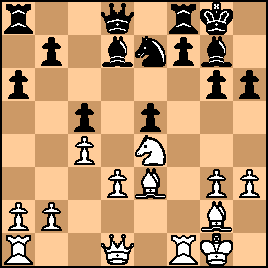
click for larger view17... Bc6
Weak. von Popiel could have exploited Mieses' unsound play with 17...b6 18. Nf6+ [best] BxN 19. RxB (Not 19. BxR? which loses after 19...Nf5 20. RxB [White has nothing better] BxR 21. Bd5 Bg5 and Black with his extra pawn and better position should win) Nf5 20. RxN BxR 21. BxR QxB with a pawn to the good but perhaps not a win because of the Bishops of opposite colors. 18. Bxc5 f5
19. Nc3 Rf7
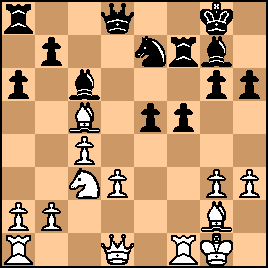
click for larger view20. Qb3?
"With the text, White sets his opponent a neat, but easily spotted, trap." (Tournament Book) After this, Mieses should surely have lost. Better were 20. BxN and 20. Nd5, as recommended in the Tournament Book. But 20. BxB or 20. Qd2 leave White with an entirely playable game. Now, White loses and pawn, and should have lost the game. 20... Qxd3
21. BxB RxB
Here was the trap. Had von Popiel played 21...Qxg3?, he would--and again as noted in the Tournament Book--have blown his edge in light of the clever 22. Nd5! But von Popiel didn't fall for that one. After Black's actual 21...RxB, the position was: 
click for larger viewMieses was here down a pawn and probably already lost. To make matters worse, as I will discuss in my next post on this game, Mieses now--whether out of desperation, time trouble, overconfidence, or sloppiness--utterly ruined what was left of his position and should clearly have lost. As we will see, however, Mieses played on and a miracle happened (i.e., dreadful play by von Popiel) and Mieses managed to save the game. |
|
Feb-12-22
 | | KEG: Post III
22. Rf2?
"!"--(Tournament Book)
"In order still to be able to meet Qxg3? with Nd5!"--(Tournament Book) Sorry, but the text was a mistake that should have allowed von Popiel to overrun Mieses. The best chance--though hardly a panacea--lay in 22. Nd5, exploiting the fact that the Black Queen is now undefended while NxR for White is check. Black would have to respond 22...Qd4+ to retain winning chances, and then after 23. Kh1 Rf7 24. Rad1 would give White some counterchances (though he should almost certainly still lose). 22... Kh7
Simpler was 22...Rf7, though the text does not really spoil anything for Black. Of course, and as previously noted, 22...Qxg3? would give White some chances to save the game with 23. Nd5. 23. Kh2?
Another thoughtless effort by Mieses. He might have tried for some play with 23. Nd5 or 23. g4 or maybe 23. BxB. After the text, things looked grim for Mieses (White): 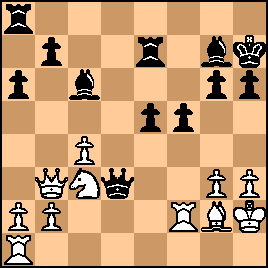
click for larger view23... f4!?
Missing the much stronger and winning 23...e4 or 23...Qd4 which would leave White without resource. Now Mieses had at least practical chances:
24. gxf4 exf4
24...BxB was also good.
25. Nd5
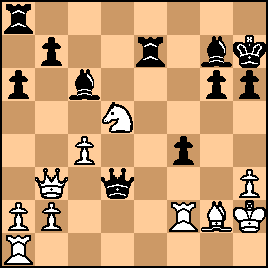
click for larger viewMieses was still theoretically lost, but now he had attacking chances of sorts and had every reason to play on. 25... QxQ
26. axQ Rf7

click for larger view27. Be4?
27. Rxf4?? Be5 would of course be fatal, as was pointed out in the Tournament Book. But the text was also bad. The natural 27. Re1 would have given Mieses at least excellent practical chances to offer resistance despite his pawn minus and doubled b-pawns. 27... Re8
28. Re1?
Setting up a potentially lethal pin. The White Bishop, come what may, had to flee with 28. Bd3 or 28. Bg2 or 28. Bh1 or whatever. Perhaps Mieses was in time trouble (there was a move-30 time control). Now, von Popiel had a devastating resource that could have ended the game right here: 
click for larger view28...f3! here is just murder. But von Popiel missed this and erred with: 28... Be5?
Once again, Mieses had a chance to try to salvage the game via 29. Bf3 (Block that pawn!) or maybe even with 29. Kg2. But Mieses blundered again with: 29. Rf3?
Why put his Rook on this square. Also, needless to say, the White b2 pawn is now hanging (though there is no rush for Black to gobble this up. 29... Kg7
Ridding himself of the pin was reasonable. Black could also have just played 29...Bxb2. 30. Kg2
30. Rg1 was perhaps a tad better.
This left:

click for larger viewWhat now followed, as I will discuss in my next post on this game, was a troubling sequence in which von Popiel kept missing simple winning lines and Mieses kept making matters worse for himself. No brilliancy prizes for this game. |
|
Feb-12-22
 | | KEG: Post IV
30... g5?!
Hard to understand why von Popiel didn't just grab the White pawn on b2 (30...Bxb2). The text hardly blew the win, but it created unnecessary King-side complications. 31. Rf2 Bd4
32. Rfe2
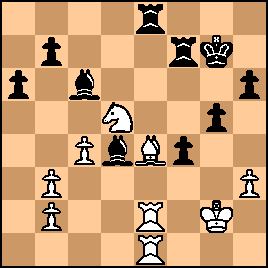
click for larger view32... h5?!
Creating more King-side issues that give White some prospects. Thanks to this move, von Popiel ultimately lost his h-pawn. 33. Bf3
Forced.
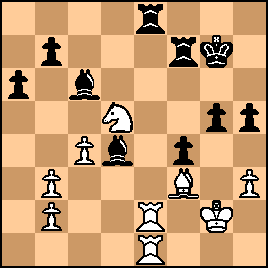
click for larger view33... Ref8
"Indirectly protecting the h5-pawn." (Tournament Book) True, but also making the win even more elusive. 33...RxR+ 34. RxR h4 was his best winning chance given his prior moves. 34. Re7?
More sloppy play by Mieses. He would likely have survived with 34. Re4. Now, once again, von Popiel had serious winning prospects. 34... RxR
35. RxR+ Rf7
36. Re4 Bxb2
Finally deigning to take the b2 pawn.
37. Bxh5
But now losing the Black h-pawn in return, a bad bargain for von Popiel. But he still had winning chances: 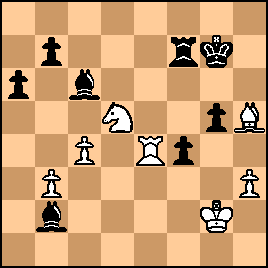
click for larger view37... Rd7
37...Rf5 or 37...Rf8 were more accurate.
38. Bf3 a5?!
38...Rd6 or 38...Bd6 were stronger.
39. Re6
39. h4 was obviously a better shot at saving the game. 39... Kf7
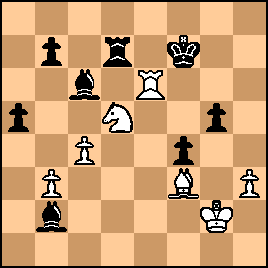
click for larger view40. Re2?
40. Rh6 was clearly better.
40... Bd4
41. Rd2?
This should have cost Mieses the game. 41. h4 was clearly indicated. 41. Re4 was also much better than the text. 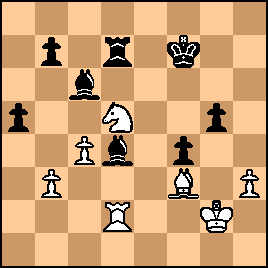
click for larger viewAnother key point in the game. Given Mieses' foibles, von Popiel almost certainly had a theoretical win. But he here (possibly because of the move-45 time control) committed a number of errors that soon allows Mieses to draw with ease. |
|
Feb-12-22
 | | KEG: Post V
41... Be3?
This lemon may or may not theoretically blow the win, but it betrays a fundamental misunderstanding of the needs of the ending. 41...Bb6 or 1...Bf6 were much better.
42. Ra2
Gaining time by requiring von Popiel to defend his a-pawn. 42... b6
43. NxB
43. Ra1 or 43. Rc2 were better.
43... BxB+
Forced.
44. KxB Rd3
44...fxN? 45. Kxe3 would obviously give Black no winning chances at all. 45. Kg4
The only chance. It left:
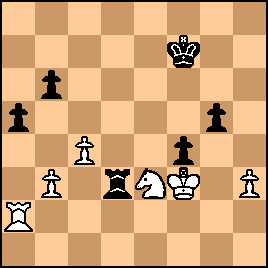
click for larger view45... RxN?
Correct, as noted by the Tournament Book, was 45...exN, which would give Black some practical chances to make progress; e.g., 46. Kxg5 (White's only chance) [the Tournament Book's suggested 46. 46. Kf3? gets creamed by 46...Rc3! (46...Rxb3 also wins) 47. b4 e2+ 48. Kxe2 axb4) Rxb3 47. Kf4 Rc3 48. Kf3 e2+ 49. Kxe2 Rxh3 with a Rook ending that might make White sweat to hold (though still a theoretical draw). After the text, the game is a clear draw both theoretically and practically. 46. Kxg5 Rxh3
46...f3 is no better.
47. Kxf4
47. c5 is a simpler way to draw.
47... Rxb3
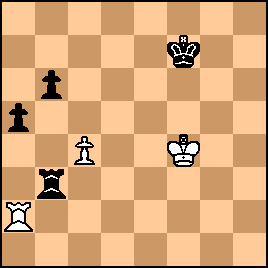
click for larger viewA book draw.
48. c5 Rb4+
49. Ke3 bxc5
50. Rxa5
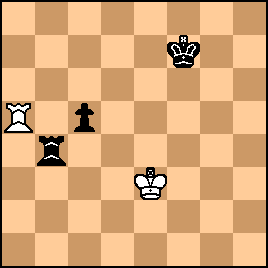
click for larger view50... Rc4
51, Kd3
Drawn |
|
|
|
|





